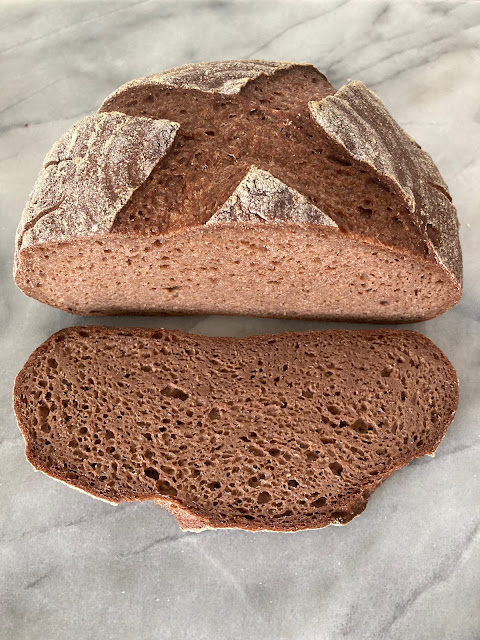Pumpernickel style Mock Rye Sourdough Bread
This recipe was made to evoke the dark, earthy flavors of rye bread, but without the gluten.
This flour blend was developed specifically for this recipe. Here’s what each flour brings to the table.
Brown
teff - dark in color and complex in flavor, teff also gives bread a
spongy and springy texture and helps with structure due to its high
amount of protein and fiber. Ivory teff is a direct substitute for brown
teff.
Quinoa
- I’ve recently gotten into quinoa again because it has a lot of great
attributes. In spite of being high in fiber and protein, it bakes off
very spongy and with a good level of moistness. It adds flexibility to
the texture of breads I’ve tried it in. It pairs well with buckwheat
for flavor. It does have a bit of bitterness to it but that is hidden
in this recipe with the two darker grains taking over the flavor
profile. Quinoa lends this bread a nice, thin, crisp crust that browns
nicely. Amaranth is usually a direct substitute for quinoa.
Pumpernickel Style Mock-rye Bread
Sourdough Version - this recipe is naturally vegan, egg-free, dairy-free.
Mix the dry ingredients:
125g brown teff flour*
125g dark buckwheat flour
90g quinoa flour
85g sorghum flour
2T flax seed, whole
25g whole psyllium husk/flakes
8.5-9g salt
1 tsp ground caraway (optional)
1 tsp ground coriander (optional)
After the dry ingredients are mixed thoroughly, mix in the wet ingredients:
50g teff starter (or try whatever kind of starter you have)
500g water at room temperature
50g (2+ TBSP) molasses (or more for a sweeter bread)
Mix the ingredients together thoroughly for a few minutes, then let rest at room temp for 90-120 minutes.
Mix in, if desired:
100g Pumpkin seeds (optional)
Mix for several minutes with the dough hook attachment, or until the seeds are evenly distributed and the dough forms a ball. (It might be possible to knead it at this point by hand, but I haven’t tried.) In the meantime, grease or oil a loaf pan, standard range of size. The smaller the pan, the taller the slices will be. A pan larger than 10x23 cm/4”x9” will result in a very short loaf. Turn out into your greased or oiled bread pan. Smooth down the top so it’s level.
Let rise at a warm temp, about 26°c/80°f for about 2.5 hours. Keep an eye on it and when the dough starts to rise, preheat the oven to 230°c/450°f. Bake when the dough has risen 1-2 cm/.5-1 inch, and the dough springs back more slowly when depressed with a finger.
Bake at 230°c/450°f, covered or steamed, for 25 minutes. If using a Pullman pan, just rest the cover on top of the pan. If not, cover with tin foil tent over the loaf pan or use steam in the oven. After 25 minutes, remove the cover/steam and bake for another 25-30 minutes. Take the pan out of the oven and gently/carefully take the bread out of the tin. Knock the bread on the bottom side with your knuckles. If it doesn’t have a distinct hollow sound, put it back in the oven, straight on the rack, and bake another 5 minutes or until it sounds hollow when tapped on the bottom. Cool on a rack.
Notes:
Hydration,
that is, the amount of liquid in a bread recipe, is not a constant.
The ideal hydration for a bread can change with humidity, climate,
altitude, temperature, the grind of the flours, pan size, bake time and
temp, and personal preference. I developed this recipe in the Pacific
Northwest where we have some humidity, about 30-87% while I was testing
this recipe. I’m at about 300 feet above sea level. The first bake
with a new recipe is always a trial run, and adjustments should be made
to the amount of liquid going forward.
Enjoy!









Comments
I am always pleased with a no-rice flour recipe.
I have made this recipe with yeast before. It’s good! It’s a little trickier somehow. The whole grain flour really needs the longer fermenting times of sourdough to absorb the water completely. So, if you decide to try this with yeast, use the least amount of yeast and the longest rise times possible. Hope that helps!